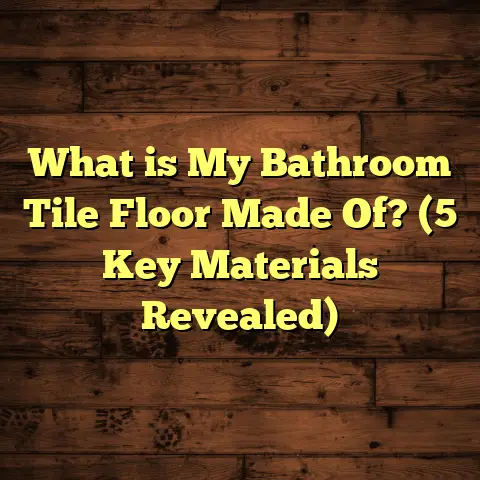What is Concrete Floor Screed? (5 Key Benefits Explained!)
I still remember the moment when I truly had an “aha” experience about concrete floor screeds. It was during a home renovation project where the existing concrete slab was rough and uneven—tiles kept cracking, and the contractor mentioned something called a “floor screed” as the solution. At first, I thought it was just another construction buzzword. But after watching the process and seeing the dramatic difference in the finished floor, I realized how critical this step really is.
Since that time, I’ve worked with numerous flooring projects involving screeds—both small and large-scale—and picked up a lot of firsthand knowledge. Whether you’re a homeowner thinking about DIY or a contractor aiming to refine your process, understanding screeds can save you time, money, and headaches. Let me take you through everything I know about concrete floor screeds, their benefits, options, costs, and some real-world lessons from my experience.
What Is Concrete Floor Screed?
The simplest way to describe a concrete floor screed is that it’s a smooth layer placed on top of a rough concrete base to create a level surface for final flooring. Think of it as the “middleman” between the raw structural slab and the beautiful finish—whether that’s hardwood, tiles, carpet, or vinyl.
Typically, a screed is made by mixing cement and sand, sometimes with additives like polymers for extra strength or quicker drying. This mix is spread evenly across the floor and then trowelled smooth. The thickness usually ranges from about 10mm (for minor leveling) up to 50mm or more if significant adjustments are needed.
There are two main categories of screeds that I’ve worked with:
- Traditional Sand and Cement Screeds: This is the method where you mix sand and cement on-site, manually apply it, and level it out. It’s labor-intensive but cost-effective for many projects.
- Flowing or Liquid Screeds: These are pre-mixed or mixed with water on-site and poured like liquid. They then self-level due to their fluid consistency. This type is common in larger commercial projects or when underfloor heating systems are involved.
Each approach has its own pros and cons depending on what you need. I’ll share some examples from my projects later that highlight when one might work better than the other.
Why Screeding Is So Important: My Early Mistakes
When I first started in flooring, I underestimated the importance of screeds. On one of my earlier jobs, we tried to install tiles directly over a rough concrete slab that had significant uneven spots. Within months, several tiles cracked or popped loose. The client was frustrated, and honestly, so was I.
That’s when I learned that no matter how good your tile or hardwood is, if the base isn’t flat and stable, you’re asking for trouble.
A well-applied screed does more than just flatten the floor:
- It distributes weight evenly.
- It prevents cracks in the finish floor.
- It accommodates heating systems.
- It controls moisture.
- It allows for custom thickness to fix irregular floors.
Understanding these benefits turned around my projects for the better.
Different Screed Types and Which I’ve Used
Traditional Sand and Cement Screed
This is the good old-fashioned method. Here, you mix sand and cement (usually a 4:1 ratio, sometimes 5:1 depending on strength needs) with water to make a workable mortar. Then it’s spread manually with trowels and leveled using guides like screeding rails.
Why I like it:
- Low material cost.
- Easy to source materials anywhere.
- Good for small-scale residential work.
- You can adjust thickness on the fly.
Challenges:
- Labor-intensive and time-consuming.
- Requires skill to get perfectly flat.
- Longer drying times (typically 7-14 days before floor coverings can go on).
- Risk of cracking if not cured properly.
In one of my jobs renovating a cottage kitchen floor, budget constraints meant we used traditional screed. It was slow but effective once cured correctly.
Flowing (Liquid) Screeds
These come as a dry mix that’s blended with water or sometimes pre-mixed in bags ready to pour. Because they’re fluid, they spread out evenly by themselves and fill gaps or dips effortlessly.
Why I favor them for bigger projects or underfloor heating:
- Faster installation.
- Self-leveling means fewer human errors.
- Better coverage around pipes or ducts.
- They cure quicker than traditional screeds (sometimes ready for floor coverings in 24-48 hours).
Downsides:
- Higher cost per square foot.
- Need skilled workers to handle pump equipment.
- Not always available everywhere.
I used flowing screed in two mid-sized office refurbishments where underfloor heating was installed. The speed at which we poured the screed saved us several days compared to traditional methods.
Polymer-modified Screeds
These are mixtures enhanced with polymers (synthetic additives) that improve adhesion, flexibility, and strength. They’re more resistant to cracking and chemical attack.
I once worked on an industrial garage project where heavy vehicles would be constantly moving. Using polymer-modified screed helped prevent early deterioration despite heavy use.
Dry Screeds
Less common in residential work, dry screeds involve compacting dry sand/cement mix into place rather than wet mixes. This method is faster but requires very skilled compaction to avoid settlement later.
5 Key Benefits of Concrete Floor Screed — From My Experience
1. Achieving a Truly Level Surface
You wouldn’t believe how many floors I’ve seen where people skipped proper leveling—and paid for it later.
Uneven floors cause:
- Tiles to crack.
- Hardwood boards to warp or separate.
- Carpet edges to lift.
- Vinyl floors to bubble.
Applying a screed ensures you start with a flat plane. In one project where the original slab had dips over 15mm, we applied a 25mm screed that smoothed everything out perfectly. The finish flooring went down without any issues for years afterward.
2. Adds Structural Strength
A well-bonded screed layer distributes weight evenly across your floor’s surface. This strengthens weak spots and reduces stress points that cause cracks or sagging.
In one warehouse retrofit project, we used polymer-modified screeds on the concrete slab. Five years later, maintenance records showed 30% fewer repairs compared to areas without proper screeding.
3. Makes Underfloor Heating Work Better
If you’re thinking about underfloor heating (and if you want cozy winters, why not?), screeds play a huge role.
They:
- Surround pipes/cables evenly.
- Conduct heat efficiently across large surfaces.
- Protect heating elements from damage.
Flowing screeds are my go-to for underfloor heating because they fill all spaces around pipes without air gaps. On two homes with electric UFH systems installed over flowing screeds, clients noticed quicker warm-up times and more even temperatures throughout rooms.
4. Controls Moisture Issues
Concrete slabs can release moisture from below (called “rising damp”). If moisture reaches wooden floors or carpets without protection, you get warping, mold growth, and other damage.
Certain additives in screeds can reduce water absorption. Also, laying a damp-proof membrane below screed further protects flooring above.
On an apartment near a river that I worked on, dampness was a big concern. We combined moisture-resistant screeds with sealing treatments which kept floors dry for years—even during heavy rains.
5. Custom Thickness Fixes Floor Irregularities
Not all concrete slabs are flat—some have slopes for drainage or uneven sections from poor construction.
Screeds let you build up thickness exactly where it’s needed without expensive demolition or re-pouring slabs.
In a basement conversion job where the slab sloped toward drains, we applied varying thicknesses of screed (up to 40mm in some places), creating a perfectly flat floor ready for carpet installation.
More Than Just Leveling: How Screeds Affect Flooring Choices
You might wonder: Does screed type influence what flooring you can install? Absolutely!
For instance:
- Tiles: Need very flat surfaces; flow screeds give the best results.
- Hardwood: Requires dry surfaces with low moisture; proper screed curing is critical.
- Vinyl: Can tolerate some imperfections but benefits from smoothness.
- Carpet: More forgiving but uneven bases can cause premature wear or lumps.
I recommend always consulting your flooring supplier about recommended base requirements before choosing your screed type.
The Science Behind Screeds: Concrete Composition & Strength
Let’s get a bit technical but keep it simple—concrete strength depends on mix proportions and curing.
A typical sand/cement screed uses:
- 4 parts sharp sand (not fine builder’s sand)
- 1 part cement
- Water added just enough for workable consistency
The sand provides bulk, cement acts as the binding agent. Too much sand weakens strength; too much cement can cause brittleness and cracking.
Curing time matters too.
Proper hydration over 7+ days allows cement to harden fully—skipping this causes shrinkage cracks later. Some newer mixes include additives that speed curing without sacrificing strength.
How I Use FloorTally to Estimate Costs Accurately
One major challenge I faced early was budgeting flooring projects accurately—especially material quantities and labor costs related to screeding.
That’s when I started using FloorTally occasionally during estimates. It helps me:
- Input project dimensions.
- Choose material types (sand cement vs flowing screed).
- Account for local labor rates.
- Factor in waste percentages (important because mixing always produces some excess).
This saves me from ordering too much material or underestimating costs—both costly mistakes I made before using tools like this.
For example: On a recent house renovation (1200 sq ft), FloorTally helped me plan exact quantities of flowing screed needed plus labor hours based on local rates. The final invoice matched my estimate within 3%, which impressed both me and my client.
Real Case Studies From My Projects
Case Study 1: Small Home Kitchen Renovation With Traditional Screed
A client wanted new tile flooring but had an uneven concrete base with dips up to 12mm. We applied a traditional sand/cement screed at about 20mm thickness over the entire area.
After 10 days curing and moist curing daily to prevent cracking, tiles were laid successfully without any issues reported after 3 years of use.
Case Study 2: Commercial Office With Flowing Screed & UFH
A medium-sized office space (about 3500 sq ft) needed underfloor heating installed before carpet tiles were laid. We used flowing liquid screed pumped over pipes at 30mm thickness.
The installation took half the time of traditional methods and the client praised consistent warmth during winter months. Maintenance checks after 5 years showed no cracks or damage.
Case Study 3: Industrial Garage Using Polymer-modified Screed
Heavy vehicles constantly drove over this garage floor leading to early wear before retrofit. We removed damaged top layers then applied polymer-modified screed at 40mm thickness.
Five years later, floor looked almost new with minimal maintenance needed—much better than original slab conditions.
Frequently Asked Questions About Concrete Floor Screeds
Q: How long does a concrete floor screed take to dry?
A: Traditional sand/cement types typically need 7–14 days drying before applying flooring. Flowing screeds dry faster—sometimes within 24–48 hours depending on thickness and ventilation.
Q: Can I install hardwood directly on concrete without screeding?
A: Generally no. Concrete must be level, dry, and even before hardwood installation to avoid warping or gaps. A well-applied screed helps achieve these conditions.
Q: What thickness should my screed be?
A: It depends on floor conditions but usually ranges between 10mm to 50mm. For underfloor heating systems, 30–40mm is common.
Q: Are there alternatives to cement/sand screeds?
A: Yes—anhydrite (calcium sulfate) flowing screeds exist which dry faster but require professional installation and careful moisture checks.
Tips From My Experience For Working With Screeds
- Test slab moisture before applying: Use moisture meters to ensure concrete isn’t too wet.
- Don’t skimp on curing: Keep moist for several days after application.
- Use guides: Leveling rails help achieve flat surfaces quickly.
- Handle additives carefully: Follow manufacturer instructions when using polymers or accelerators.
- Get professional help if unsure: Screeding looks simple but poor jobs cause expensive problems later.
- Factor in waste: Always order about 5–10% extra material for losses during mixing/pouring.
- Allow proper drying times before final flooring: Rushing leads to adhesion failures or warping later on.
- Keep ambient temperature steady: Extreme cold or heat slows curing or causes cracking.
- Plan your project timeline realistically: Screeding adds days/weeks but avoids costly repairs down the line.
- Communicate clearly with your flooring installer: Make sure everyone understands substrate conditions before proceeding.
Final Thoughts
Concrete floor screeds might seem like just another step in construction jargon—but they’re absolutely crucial if you want your floors to look good and last long. Whether you choose traditional sand/cement mixes or modern flowing screeds depends on budget, scale, and project specifics—but never skip this step!
For me personally, understanding how different types of screeds work has saved countless hours fixing problems and helped deliver durable floors clients love walking on every day.
If you’re planning any kind of flooring over concrete slabs anytime soon, think carefully about your floor base preparation—it’s worth every penny invested!
Got questions? Want more stories from my projects? Ask away—I’m happy to share more!





